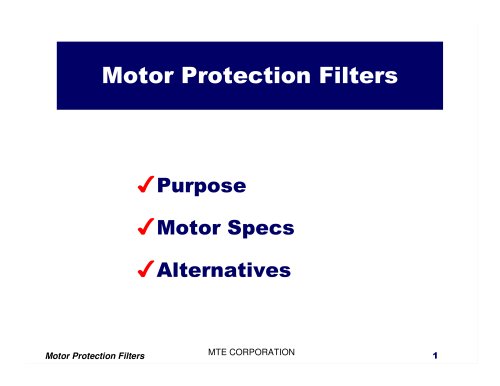 Website:
MTE
Website:
MTE
Group: SL Industries
Catalog excerpts

MTE Corporation Abstract: Users of variable frequency drives often have strict demands placed on them to mitigate harmonic distortion caused by non-linear loads. Many choices are available to them including line reactors, harmonic traps, 12-pulse rectifiers, 18-pulse rectifiers, and low pass filters. Some of these solutions offer guaranteed results and have no adverse effect on the power system, while the performance of others is largely dependent on system conditions. Certain techniques require extensive system analysis to prevent resonance problems and capacitor failures, while others can be applied with virtually no analysis whatsoever. In some cases harmonic mitigation technique decisions were based on a technical misunderstanding, lack of information, theoretical data or on invalid assumptions. This paper explains the theory of operation of various passive harmonic mitigation techniques and demonstrates their typical real life performance. It takes the guesswork out of harmonic filtering by demonstrating the typical performance of various harmonic mitigation techniques and offering a quantitative analysis of alternatives for real life VFD operating conditions. 1.1 Typical Harmonic Performance The typical harmonic spectrum data for a six-pulse rectifier load fed by a stiff power source (0.25% and 0.5% impedance) is as follows: 1 SOURCE REACTANCE The magnitude of harmonic currents in an individual non-linear load depends greatly on the total effective input reactance, which is comprised of the source reactance plus added line reactance. Given a six pulse rectifier with dc bus capacitor, one can predict the resultant input current harmonic spectrum based on the input reactance. The lower the source reactance, (the more stiff the power source), the higher the harmonic content will be. 0.25% 0.50% h > th reactance reactance 5 > th 102% 78% 7 > th 92% 58% 11 > th 26% 18% 13 > th 14% 10% 17 > th 10% 7% 19 > rd 8.5% 6% 23 > th 7% 5% 25 3% 2.3% THID 141% 100% (THID = total harmonic current distortion) >
Open the catalog to page 1
2.1 Typical Harmonic Performance of Reactors The typical harmonic spectrum data for a six pulse VFD load fed by a power supply with an effective source reactance of 3%, 5% and 8% looks as follows: 3 % 5% 8% impedance h 2 LINE REACTORS Fig 1 . Fig 1. The use of AC line reactors is a common and economical means of increasing the source impedance relative to an individual load. Line reactors are connected in series with the six pulse rectifier diodes at the input to the VFD, as shown in Since power distribution transformers frequently have impedance ratings between 1.5% and 5.75%, one would...
Open the catalog to page 2
Fig. 2(a) Input Current waveform of Fig. 2(b) Input current of 6-pulse 6-pulse rectifier w/0.5% impedance rectifier w/ 3% impedance > 5% Impedance Reactor & 3% DC Choke >
Open the catalog to page 3
4 12-PULSE RECTIFICATION Fig. 6 Input current waveform for a Six-pulse rectifier with 5 Fig. 6 4.1 Theory of performance > L5.I... 441.3m500.0m462.5m0 Twelve pulse rectifier configurations have been used for applications demanding lower harmonic levels than can be achieved using either traps or reactors. The theoretical benefits of 12-pulse rectification include cancellation of 5 > th harmonic tuned harmonic filter, measured at 50% load, and with 3% line voltage unbalance and 0.25% source impedance. Harmonic current distortion = 139% THID > th , 7 > th , 17 > th , 19 > th , etc harmonics....
Open the catalog to page 5
5.3 Effects of Unbalanced Line Voltage on 18-pulse Rectifiers Similar to twelve pulse systems, 18-pulse rectifiers experience diminishing performance when line voltages are not balanced, and when operating at less than full load. 18-pulse drives may offer guaranteed harmonic distortion levels, but typically only at full load and full speed conditions, with voltages that are balanced within one percent. Fig. 10 illustrates the effect of unbalanced line voltages on 18-pulse drives operating between full load and no load conditions. Notice that as the load is decreased the magnitude of percent...
Open the catalog to page 8
1 8 -P u l se Driv e 18-Pulse Drive with 5% Line Reactorsfor Each Rectifier > Total Harmonic Current Distortion, THID, % 0102030405060708090100
Open the catalog to page 9
18 Pulse Drive vs. 6-pulse VFD with Matrix Filter Fig. 13 > 18-Pulse Drive 3% Line Unbalance2% Line Unbalance1% Line Unbalance 8% Matrix Filter 3%Unbalance 2% Unbalance1% Unbalance Total Harmonic Current Distortion THID, % 010 20 30 40 50 60 70 80 90100 0102030405060708090100110 Load, % Fig. 8, Fig. 11 and Fig. 13 . Tuned 5 7 TRIPLEN HARMONICS Triplen harmonics are typically not present in a balanced three phase system. They occur however when the line voltages are not balanced, or when the line voltage is distorted by non- linear single phase loads. The presence of triplen harmonics...
Open the catalog to page 11
harmonic performance guarantees, while others may require extensive analysis. This paper demonstrates that theoretical performance is not necessarily a valid estimate of the actual expected performance of most mitigation techniques when operating under real life conditions. The performance level of most techniques diminishes in the real world due to the presence of unbalanced line voltages and operation at less than 100% loading conditions. >
Open the catalog to page 12All MTE catalogs and technical brochures
-
Noise Suppression Network
2 Pages
-
Guard-AC? PLUS
2 Pages
-
RFI and EMI Filters
2 Pages
-
Matrix PureSine ®
2 Pages
-
RL Line/Load Reactors
2 Pages
-
RLW Reactors
2 Pages
Archived catalogs
-
DC Link Chokes
2 Pages
-
Matrix Filters®
2 Pages
-
Harmonic Filter Tutorial
36 Pages
-
Motor Protection Filter Tutorial
11 Pages
-
Load Reactor Tutorial
13 Pages
-
Line Reactor Tutorial
15 Pages
-
RFI / EMI Filter Tutorial
17 Pages
-
Harmonic Filters
4 Pages
-
Motor Protection Filters
2 Pages
-
MTE Corporation - Catalog
9 Pages























